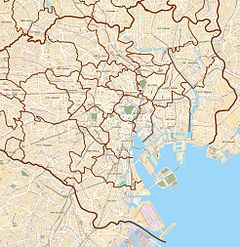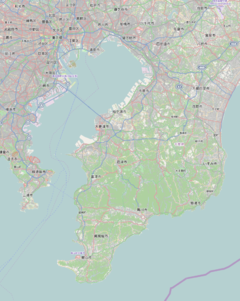This article needs additional citations for verification. (May 2022) |
Hatchōbori Station (八丁堀駅, Hatchōbori-eki) is a railway station in Chūō, Tokyo, Japan, operated by both the Tokyo Metro and the East Japan Railway Company (JR East).
JE02 H12 Hatchōbori Station 八丁堀駅 | |||||||||||||||||||||||||||||
|---|---|---|---|---|---|---|---|---|---|---|---|---|---|---|---|---|---|---|---|---|---|---|---|---|---|---|---|---|---|
 Entrance to Hatchobori Station | |||||||||||||||||||||||||||||
| General information | |||||||||||||||||||||||||||||
| Location | 3-25-10 Hatchōbori, Chūō, Tokyo (東京都中央区八丁堀三丁目25-10) Japan | ||||||||||||||||||||||||||||
| Operated by | |||||||||||||||||||||||||||||
| Line(s) |
| ||||||||||||||||||||||||||||
| Construction | |||||||||||||||||||||||||||||
| Structure type | Underground (all lines) | ||||||||||||||||||||||||||||
| Accessible | Yes | ||||||||||||||||||||||||||||
| Other information | |||||||||||||||||||||||||||||
| Station code | JE02, H12 | ||||||||||||||||||||||||||||
| History | |||||||||||||||||||||||||||||
| Opened | 28 February 1963 | ||||||||||||||||||||||||||||
| Passengers | |||||||||||||||||||||||||||||
| JR East, FY2010 | 28,969 daily | ||||||||||||||||||||||||||||
| Services | |||||||||||||||||||||||||||||
| |||||||||||||||||||||||||||||
| |||||||||||||||||||||||||||||
Lines
editHatchōbori Station is served by the Hibiya Line subway and the Keiyō Line from Tokyo to Soga. The station is also served by Musashino Line through-running services between Tokyo and Fuchūhommachi. It is located 9.7 km from the starting point of the Hibiya Line at Kita-Senju,[1] and 1.2 km from the western terminus of the Keiyō Line at Tokyo Station.[2]
Station layout
editHatchōbori Station consists of two individual stations run by different rail operators connected by underground passageways.
Tokyo Metro platforms
editThe Tokyo Metro station consists of an underground island platform serving two tracks.
| 1 | H Hibiya Line | for Ginza, Roppongi, and Naka-Meguro |
| 2 | H Hibiya Line | for Ueno and Kita-Senju TS Tobu Skytree Line for Tōbu-Dōbutsu-Kōen TN Tobu Nikko Line for Minami-Kurihashi |
JR East platforms
editThe JR East station also consists of an underground island platform serving two tracks. The JR line platform is deeper underground than the Hibiya Line platform.[2]
| 1 | JE Keiyō Line | for Maihama and Soga |
| JM Musashino Line through service | for Nishi-Funabashi and Fuchūhommachi | |
| 2 | JE Keiyō Line | for Tokyo |
-
Keiyo Line platforms
History
editThe Tokyo Metro (formerly Eidan) station opened on 28 February 1963.[1] The JR East station opened on 10 March 1990.[2]
The station facilities of the Hibiya Line were inherited by Tokyo Metro after the privatization of the Teito Rapid Transit Authority (TRTA) in 2004.[3]
Station numbering was introduced to the JR East platforms in 2016 with Hatchobori being assigned station number JE02.[4][5]
Passenger statistics
editIn fiscal 2010, the JR East station was used by an average of 28,969 passengers daily (boarding passengers only).[6]
Surrounding area
editThe station is located in the Hatchōbori neighbourhood of Chūō, Tokyo.
See also
editReferences
edit- ^ a b Terada, Hirokazu (July 2002). データブック日本の私鉄 [Databook: Japan's Private Railways]. Japan: Neko Publishing. p. 213. ISBN 4-87366-874-3.
- ^ a b c Kawashima, Ryozo (December 2009). 日本の鉄道 東海道ライン 全線・全駅・全配線 第11巻 東京南東部・千葉北西部 [Railways of Japan – Tokaido Line – Lines/Stations/Track plans – Vol 11 South-east Tokyo and North-west Chiba]. Japan: Kodansha. p. 38. ISBN 978-4-06-270021-4.
- ^ "「営団地下鉄」から「東京メトロ」へ" [From "Teito Rapid Transit Authority" to "Tokyo Metro"]. Tokyo Metro Online (in Japanese). 8 July 2006. Archived from the original on 16 May 2012. Retrieved 29 May 2022.
- ^ "⾸都圏エリアへ 「駅ナンバリング」を導⼊します" [Introduce “station numbering” to the Tokyo metropolitan area] (PDF). jreast.co.jp (in Japanese). 6 April 2016. Archived from the original (PDF) on 7 December 2022. Retrieved 7 January 2023.
- ^ Kusamachi, Yoshikazu (7 April 2016). "JA・JK・JT・AKB…JR東日本、首都圏で駅ナンバリングなど導入へ" [JA, JK, JT, AKB … JR East to introduce station numbering in the Tokyo metropolitan area]. Response Automotive Media (in Japanese). Archived from the original on 6 August 2022. Retrieved 7 January 2023.
- ^ 各駅の乗車人員 (2010年度) [FY2010 Station passenger figures] (in Japanese). Japan: East Japan Railway Company. Retrieved 30 January 2012.
External links
edit- Tokyo Metro station information (in Japanese)
- JR East station information (in Japanese)



